This article originally appeared at GunsAmerica.

I find the XD-S to be the perfect size for easy concealed carry.
With this new XD-S chambered in .40 caliber, Springfield Armory has covered the bases with the most popular self-defense calibers for semi-automatic pistols. Originally available in 9mm and .45 ACP, the new .40 S&W model provides an interesting option for law enforcement and concealed carry users alike.
“While customers appreciate the choice between 9mm and .45 ACP in the XD-S® lineup, we wanted to make things easier for our law enforcement users,” says Dennis Reese, Springfield Armory® CEO. “Many departments are standardized on the .40 caliber, and we wanted to make it easier to choose the XD-S® as a backup to their primary service weapon. Besides, many concealed carry customers prefer to carry the same caliber as their local law enforcement officers, so they’ll appreciate having the option of a .40 caliber model too.”

Springfield Armory XD-S .40 caliber, right side.
I’ve used the 9mm and .45 ACP versions – a lot. In fact, I wrote a book about these two guns shortly after they hit the market. So how does the XD-S .40 caliber stack up? Let’s take a look.

Springfield Armory XD-S .40 caliber, left side.
What’s In The Box?
The basic packaging of the new XD-S® .40 caliber includes the gun, two magazines, one additional backstrap insert and the usual gun lock and owners materials.

The basic gun includes a small hard case with lockable catches, a flat base and extended magazine, grip size adjustment and the standard gun lock.
One of the magazines has a flush base to minimize overall size. This one holds six rounds of .40 caliber plus one in the chamber. With the flush magazine installed, I can fit my middle and ring fingers on the grip along with exactly one-half of my pinky. Unlike a slightly shorter grip where I have to fold the pinky underneath, I get good support.
The second included magazine is called the Mid-Mag. It’s about ¾-inch longer and adds a seventh round. It comes with a magazine sleeve, so the longer magazine also serves as a grip extension. In the “nice touch” department, Springfield Armory includes a second sleeve whose profile matches the alternate backstrap insert. Whichever backstrap size you choose, there’s a matching grip sleeve, so the extended grip is seamless.

Springfield Armory includes an additional sleeve with the extended magazine that mates perfectly with the second grip size adjustment backstrap.

A short, one-notch Picatinny rail segment is there in case you want to mount a light or laser.
The gun comes in a small plastic hard case and has dual sliding latches, both equipped with padlock holes. Technically, it’s good to go per TSA rules, but the case is not designed to be “break it into pieces and steal what’s inside” proof, so for travel I would invest in a theft-resistant case.
The Quick Tour
The XD-S is a svelte gun. At just 0.9 inches wide, this model is shockingly easy to conceal in any of the available calibers. As you might guess, it’s a single-stack design – that explains its 6+1 and 7+1 capacity.
Overall length is 6.25 inches while height from the bottom of the flush magazine to the top of the sights is 4.25 inches. It weighs 22 ounces empty, so it’s not the lightest compact on the market. That’s one of the benefits of the XD-S however. As we’ll discuss in a bit, these are surprisingly shootable guns for their size.

Like a 1911, all XD-S pistols come with a standard grip safety.

The magazine release button is present on both sides – no need to swap it from left to right.
The magazine release buttons are fully ambidextrous, meaning there’s already one on each side – you don’t have to reverse it if you’re left-handed. The slide lock lever is on the left side only, but that’s an administrative control so no matter. Like other XD models, the XD-S .40 caliber has a grip safety that depresses on the assumption of a proper firing grip, kind of like a 1911. Combined with the trigger leaf insert safety, this gun is exceptionally unlikely to “go off” by surprise. That can only happen if you grip it, depressing the grip safety, AND intentionally pull the trigger. With this kind of redundancy, it should be a comforting concealed carry configuration. I have no qualms about carrying this gun in any type of proper holster. In fact, I’ve been carrying this one frequently using a Galco Pocket Protector holster. The slim profile makes it a great pocket gun. We’ll get into some of the carry methods I tested with this gun in a minute.
The barrel is 3.3 inches long, and sight radius is 5.5 inches. The fiber optic tube up front jumps into view with little if any distraction from the low-profile combat rear sight. The notch in the rear sight is flanked by two white dots. By the way, it’s easy to swap out the fiber optic tube. Using a lighter and sharp knife, you can remove the installed red tube and replace it with green if you like.
The XD-S .40 caliber includes a short, single-slot Picatinny rail up front in case you want to attach a light, laser, or bayonet if you’re feeling particularly Rambo-like.
Trigger
The trigger on my sample XD-S® .40 had almost exactly ¼” of take-up with 2 ½ pounds of pressure followed by a constant pressure break sequence. The trigger broke every time right at 7 ½ pounds of pressure. The feel is almost entirely grit-free, and the pressure up to the break point is smooth.

Cocking serrations are on the rear of the slide only.
I find the 7 ½ pound trigger weight ideal for a gun like this. It’s smooth enough to fire accurately with ease and heavy enough to provide an extra measure of safety for deep concealment carry. Obviously, this is a user issue, but I prefer a heavier trigger on a gun I might carry in a pocket holster. The tight confines inside a pocket during a draw make it more difficult to absolutely and positively avoid contact between a finger and the trigger. But that’s just my preference.
Carrying the XD-S .40
I found this gun to be insanely easy to carry concealed. Almost all of the credit for that award goes to its incredibly thin profile. At just .9 inches thick, it’s one of the most comfortable handguns to carry inside the waistband. The small overall dimensions also allow it to work in a pocket holsters, depending of course on the pocket in question. I found myself using three different carry configurations with this little portable gun.

The CrossBreed SnapSlide is a great option for OWB carry. Note the high positioning of the gun relative to the beltline.
My most common carry scenario for the XD-S .40 was inside the waistband using an N82 Tactical Original holster. This design features a large back panel constructed of suede, neoprene, and oil-tanned leather. The suede layer is on the inside for comfort but also provides stability from friction. The neoprene acts as a barrier to keep sweat away from your gun and oil away from your body. The gun side is made from leather for durability and smoothness of draw. This holster is ridiculously comfortable with the XD-S. The back panel is large enough to prevent the gun grip texture from contacting your sensitive side parts and the overall thin package disappears with even a tighter cover garment. I highly recommend this combination.
For pocket carry, I’ve been using the Galco Pocket Protector holster. First, ALWAYS use a holster when carrying in your pocket. OK, rant over. The Pocket Protector features a flat and wide base to keep the XD-S oriented vertically even through much of the weight is up high in the full magazine. The rough side out leather provides enough friction to keep the holster in your pocket during the draw, although that is aided by a hook designed into the leather wing section. The hook is designed to catch on the inside of your pocket, thereby preventing the holster from coming out with the gun. The top is reinforced inside to allow for easy gun insertion. Bottom line? This holster works great with the XD-S. Always test your pockets to make sure that the pocket mouth is large enough to draw with a decent firing grip.
The last configuration I’ve been using is a CrossBreed Holsters SnapSlide molded for the XD-S with a Crimson Trace Laserguard. What I like about this one is the very high mount relative to the beltline. That combined with the short overall length of the XD-S makes for a very easy to conceal the gun, even when carried outside the pants. The large leather backing surface and belt loops separated by six inches make for a very stable rig. Of course, you can order a SnapSlide configured for an XD-S without the Laserguard too.

The Crimson Trace Laserguard is designed specifically for the XD-S. Note how the activation button integrates with the grip texture.

I installed this Crimson Trace Laserguard for testing. It worked like a champ and the green laser was clearly visible in daylight conditions at my outdoor range.
One more comment: If you wear pants with cargo pockets, check out the Recluse Holsters TS Cargo model. It’s specifically designed for extra large pockets and will prevent the gun from falling over sideways inside the larger pocket interior. A clever front panel completely hides the outline of your handgun. It’s excellent.
While I didn’t test this configuration, the XD-S would make an excellent choice for ankle carry. The low overall height from the base of the magazine to the top of the slide will make this perfectly compatible with a good ankle holster. I’m not crazy about ankle carry for my primary gun, but the small size of the XD-S would make it an excellent backup option. For you law enforcement officers out there who may be standardized on .40 S&W for your service gun, this might be a good ammo-compatible backup option to consider.
Shooting The XD-S .40 And The Recoil Olympics
Felt recoil is a pretty subjective measure. Generally speaking, using a similar gun, I find that the .40 S&W feels snappier than a .45 ACP, which tends to feel like more of a “push” than a “jolt” to me. Of course, 9mm is tamer than either of the larger bore options.

I tested several common self-defense loads with widely varying bullet weights.
As I write this, I happen to have (nearly) matching XD-S pistols in all three calibers. I liked the original 9mm and .45 ACP XD-S pistols so much I bought one of each. I figured this was a great opportunity to report on the subjective felt recoil differences between all three. I shot all three using their flush magazines as I felt that was the most likely concealed carry combination. All three models come with extended magazines that offer more surface area and probably help mitigate the “felt” part of recoil.
The subjective part of this is predictable. The 9mm model is a breeze to shoot well. Recoil is light, and the gun is large enough not to be jumpy in the hand. The .45 ACP is surprisingly shootable. The slower and heavier bullet generates some kick, but it’s more of a push than a sharp snap. The new XD-S .40 caliber feels like it has more recoil than the other two, but I suspect that’s a result of the velocity of the recoil impulse – you feel the force in a shorter amount of time.

The captive dual recoil springs not only help with reliable function, but tame recoil as well.
I found that ammo choice made a big difference. The Barnes TAC-XPD ammo with its 140-grain bullet was very comfortable to shoot – there was no sharp kick at all, and it felt closer to a 9mm than a the other .40 rounds. The Speer Gold Dot 180-grain was also surprisingly mild, feeling more like the slow push of a .45 ACP fired from an XD-S. The Winchester PDX1 round had the most felt recoil of the bunch due to its velocity and bullet weight combination.

The rear sight is serrated to minimize glare in the sight picture.

The front fiber optic sight is red, but you can easily change it out in a few minutes with a knife and lighter.
So that’s how it felt to me. Doing some fancy math, I calculated the recoil energy of each gun with a representative load for its caliber. Keep in mind that foot-pounds of recoil energy is just one component of what recoil “feels” like and that recoil energy varies with each bullet weight, velocity, and powder charge weight combination for any given gun. Here’s what I figured:
XD-S 9mm: 5.10 foot-pounds (124-grain bullet at 1,150 fps)
XD-S .45 ACP: 8.15 foot-pounds (230-grain bullet at 790 fps)
XD-S .40 S&W: 6.92 foot-pounds (180-grain bullet at 920 fps)
The bottom line is that ammunition choice matters. If you go with an XD-S .40, try some different types of ammo with different bullet weight and velocity combinations to see what you like, and more importantly, what you can control.

The takedown lever rotates up when the slide is locked back. This allows removal of the slide, barrel and recoil spring assembly.
Accuracy And Velocity Testing
The XD-S .40 caliber features a 3.3-inch barrel, so I wanted to see what type of velocity I would get from a variety of self-defense loads. I chose these four: Hornady Critical Duty 175-grain, Barnes TAC-XPD 140-grain, Speer Gold Dot 180-grain, and Winchester PDX1 165-grain. To get average velocity figures, I set up a Shooting Chrony Beta Master Chronograph 15 feet down range and calculated average velocities for each load.
| Ammunition | Average Velocity (feet per second) |
| Hornady Critical Duty 175-grain | 956.6 |
| Barnes TAC-XPD 140-grain | 966.9 |
| Speer Gold Dot 180-grain | 922.1 |
| Winchester PDX1 165-grain | 949.3 |
For accuracy testing, I mounted a Crimson Trace Laserguard to the XD-S. The Laserguard is a custom-built unit specifically for the XD-S that attaches to the front rail and connects to an instinctive activation button on the front side of the grip via a trigger guard liner. The laser gave me a near perfect sight picture on targets placed 15 yards down range. For each ammo type, I fired multiple five-shot groups and calculated an average group diameter.
| Ammunition | Average Group Size (five-shots at 15 yards) |
| Hornady Critical Duty 175-grain | 1.855 inches |
| Barnes TAC-XPD 140-grain | 1.95 inches |
| Speer Gold Dot 180-grain | 1.265 inches |
| Winchester PDX1 165-grain | 1.355 inches |
I got the best group of the outing with the Winchester PDX1 Defender loads. Those left a single, irregular hole with all five holes interconnected. The Speer Gold Dot 180-grain load turned in a single hole four-shot group with one flyer. What was interesting was that point of impact was consistent for all four ammo types with the average group centers being within an inch of each other. At self-defense ranges, your choice of ammo isn’t going to be a factor in terms of the sights matching up with the point of impact.

I got consistent groups with all ammunition tested, but this five-shot group of Winchester PDX1 Defender was the tightest of the day.
Closing Thoughts
The interesting thing about Springfield Armory’s XD-S pistols is that they are well suited to serve as a primary carry gun and as a backup to a larger pistol. Most compact guns in 9mm, .40 S&W, and .45 ACP are notoriously un-fun to shoot. Small and light generally does not go well with heavier recoil of full-power calibers. I’ve always found the XD-S platform to be surprisingly comfortable and controllable – in other words, easy to shoot well. It’s big enough to handle, but small enough for easy concealment.

A chamber status indicator can be seen and felt if a round is present and chambered.

Chamber indicator when a round is loaded.
The XD-S .40 S&W model is certainly snappier than the 9mm, and feels a little bit “sharper” in terms of felt recoil, but that’s the case with any handgun chambered in that caliber. Physics is physics after all. If you feel comfortable with a .40 for it’s larger diameter and more capacity than the .45 ACP, take a look. The XD-S is a great carry gun, and now you have your choice of 9mm, .40 S&W, and .45 ACP.


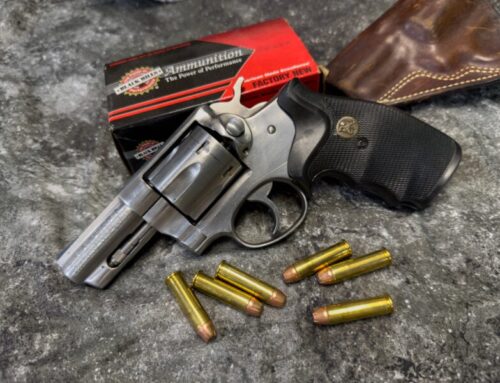
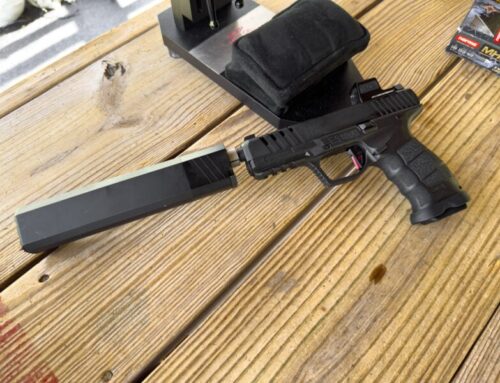
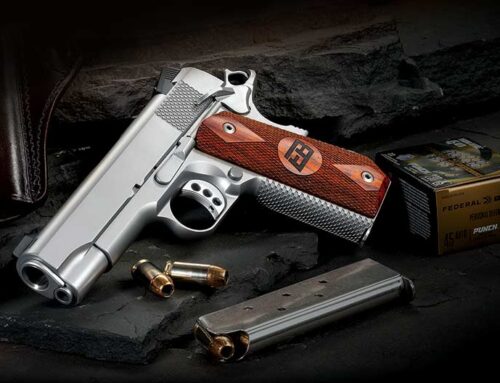
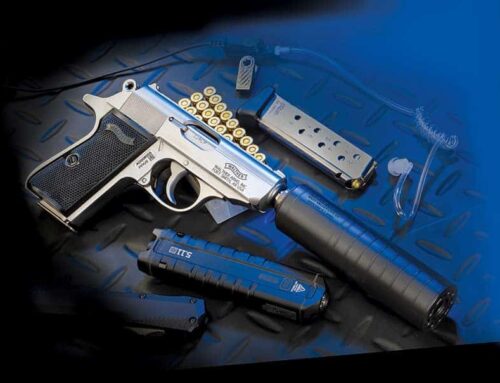
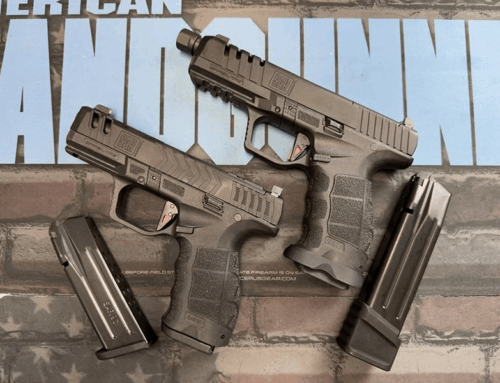

Leave A Comment